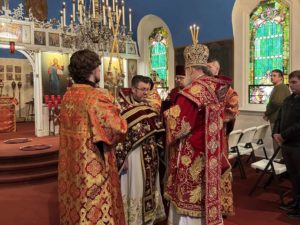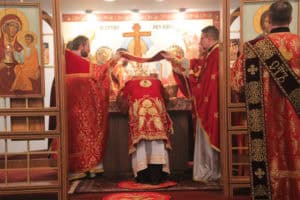Endearing and Enduring
Archpriest Paul Jannakos
“Endearing and Enduring.”
These two words we consider as we remember and honor our beloved Archbishop Paul – brought to this Church, his home parish, for the last time.
So first, Endearing. What does it mean to endear oneself to another? What a beautiful word we have in our English language, this word “endear.” It means that we show mutual love and affection for one another. In his epistles. Saint Paul writes that we must show “brotherly love” towards each other in the church, which is the family of God. In the Greek this phrase brotherly love is “philostorgia.” (Rom. 12:10). It means to love with affection. Like the love of a mother for her children, by embracing them, caressing them, kissing them, etc. We know that young children, infants and toddlers especially, need this kind of physical affection and that without it they cannot grow or thrive. Archbishop Paul, I believe, was all about this kind of loving affection. He was an Archbishop and “carried” himself as such. But after giving his hierarchical blessing he was quick to offer a warm hug, the embrace of a true father. He loved the members of his diocese and rejoiced in each of them, young and old. His favorite part of being a diocese hierarch, certainly, were his regular weekend parish vistations. Shortly before his hospitalization he was informed that because of his failing health he could not make his scheduled visit (to St. Matthew’s parish in Green Bay). He wept after hearing this.
The second word we consider tonight about him is “enduring.” Archbishop Paul endured in his work. He labored continuously and intensely for the welfare of his diocese. He did this not because he was a “workaholic,” (though from the outside it would appear thus so), but because he loved what he did, and he genuinely loved the work of his episcopal ministry. Quite literally, Archbishop Paul never stopped laboring for Christ’s Church. As his chancellor he would call me every Monday morning around 7:30 or 8:00am after a long 3 or 4 day weekend drive to one of his parishes. He made sure to get things set up for the rest of the week. Once in a while I would respond, “Master bless! Good morning, do you ever take a day off?!” Our Archbishop was with us for a short 7 years; but by the grace of the Holy Spirit he accomplished so very much! The diocese grew spiritually, numerically, financially. New parishes were established. Pastoral initiatives were implemented: charities, mission, education, music, continuing education for clergy, and lay engagement. His Eminence above all else loved to serve the Eucharist and the services; but he knew, too, that the “liturgy after the Liturgy” was just as important. He was not content to just serve the services and take a nice “PLN” (“post-liturgical-nap).
The Archbishop was born from Greek immigrants who came from a village in Northern Greece near the city of Epirus. And although he was one not to trumpet his ethnicity, I believe he was strongly influenced by the example of his mother and father. The Greeks from this region were known for being especially resourceful and industrious. Though he never called himself a “Greek-American,” (Once in a blue moon he would remark that he was an “American-Greek”), he still manifested the same positive family traits. For as the saying goes, “the apple does not fall far from the tree.”
Archbishop Paul had a knack for names. He would remember everyone’s name, and the name of their parents, their children, added to that, the name of their first cousin who attended another parish in some far-flung parish at the other end of the diocese. “Oh yes, you’re so and so’s niece from St. Mary’s in Minneapolis.”) Names were important because it was the way he saw the mystical face of Christ in each of them. Here I’m reminded of a well-known monk-priest in Romania who was also a famous iconographer, +Fr. Arsenie Boca, who once said that “to paint the face of Christ upon a piece of wood, many people can do. But to paint the face of Christ upon another human soul, this is a miracle of the Holy Spirit.” This is the kind of pastoral “iconographer” Archbishop Paul was, he sought to paint the face of Christ upon everyone he met. When St. Paul writes that “Christ is all in all,” (Col. 3:11) it not only means that we must experience the presence of Christ in all creation, but more importantly, that we recognize the face of our Lord behind every human face, no matter how broken or sinful or destitute.
Finally, I would also like to say that at the end, during his six weeks in the hospital in Chicago, he bore his sufferings faithfully, nobly even. My spiritual father, Fr. Thomas Hopko used to say, “the last act of our faith in Christ in life is the way we meet our death.” At first it was not easy for the Archbishop to surrender “self-agency” to the physicians and nurses in the hospital as they like to say in psychological circles. He was humbled by the fact that he had to be served by others instead of serving others himself. (A common experience among elderly clergy). And having undergone numerous tests the first week in the hospital he was a bit frustrated that it was taking so long for a diagnosis. But once he was told about his terminal cancer he was quite peaceful and resolved. Hundreds of bishops, priests, and faithful came to the hospital to receive their last blessing. Many of these faithful, too, during holy week, stayed with him in his room 24/7 in order to pray the psalms with him.
Our beloved Archbishop died on Pascha morning, with his sister Agatha at his side, at exactly 3:00am, after all of his priests and people finished their paschal liturgies. Who could have asked for such a blessed end? A deathless death to be sure! Christ is Risen! Indeed he is risen!



